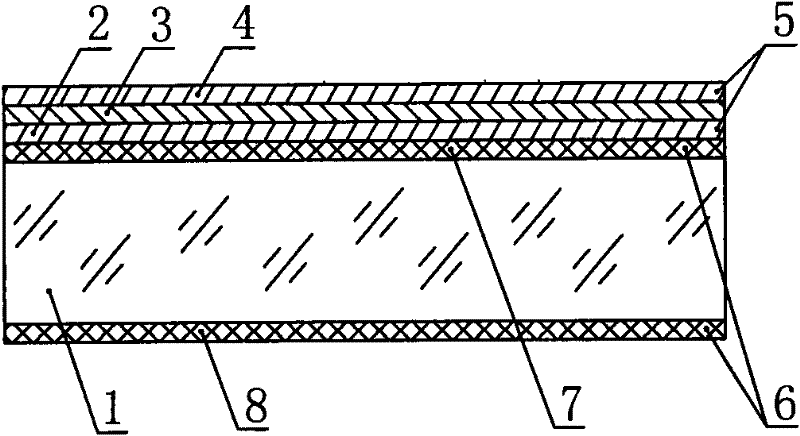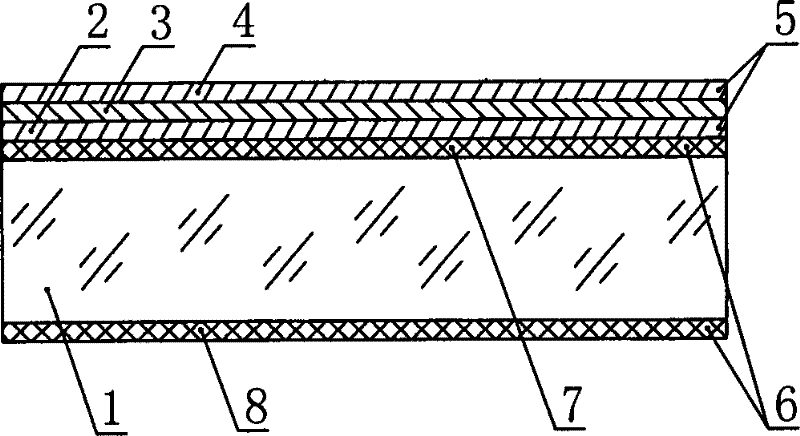Conductive glass with double anti-reflective film surfaces for thin film solar battery and preparation method thereof
A solar cell and anti-reflection film technology, which is applied in the fields of solar energy materials and photoelectric new materials, can solve the problem that the light transmittance, conductivity and scattering degree of conductive glass have not been greatly improved, and solar energy cannot be fully utilized and converted. Problems such as the number of metal oxide conductive layers, etc., to achieve good anti-reflection effect, dense and uniform film structure, and excellent electrical conductivity
- Summary
- Abstract
- Description
- Claims
- Application Information
AI Technical Summary
Problems solved by technology
Method used
Image
Examples
Embodiment 1
[0029] As shown in the drawings, a conductive glass for thin-film solar cells with double-sided anti-reflection films includes a glass substrate 1 , a transparent conductive film 5 , and an anti-reflection film 6 . The transparent conductive film 5 includes a metal oxide conductive layer 2 and a second metal oxide conductive layer 4 . The antireflection film 6 is composed of a first antireflection film 7 and a second antireflection film 8 . A metal layer 3 is interposed between the metal oxide conductive layer 2 and the second metal oxide conductive layer 4, the first anti-reflection film 7, the metal oxide conductive layer 2, the metal layer 3 and the second metal oxide conductive layer 4 is sequentially deposited on one side surface of the glass substrate 1, and the second anti-reflection film 8 is arranged on the other side surface of the glass substrate 1. The glass substrate 1 is common float white glass with a thickness of 3.2mm. The thickness of the metal oxide conduc...
Embodiment 2
[0039] As shown in the accompanying drawings, a conductive glass for thin-film solar cells with a double-sided anti-reflection film, the structure of the conductive glass of this embodiment is basically the same as that of the first embodiment. 3 is silver thin film, the second metal oxide conductive layer 4 is SnO 2 :F. The difference from Example 1 is: the glass substrate 1 is ultra-clear float glass with a thickness of 3.2mm; the thickness of the metal oxide conductive layer 2 is 150nm, the thickness of the metal layer 3 is 30nm, and the second metal oxide The conductive layer 4 has a thickness of 250nm, the film thicknesses of the first anti-reflection film 7 and the second anti-reflection film 8 are both 80nm, the refractive index value of the first anti-reflection film 7 is 1.55-1.8, and the second anti-reflection film 8 The refractive index value is 1.22~1.4.
[0040] A preparation method for realizing the above-mentioned conductive glass for thin-film solar cells wit...
Embodiment 3
[0049] As shown in the accompanying drawings, a conductive glass for thin-film solar cells with a double-sided anti-reflection film, the structure of the conductive glass of this embodiment is basically the same as that of the first embodiment, the metal layer 3 is a silver film, and the second metal oxide The conductive layer 4 is SnO 2 :F. The difference from Embodiment 1 is: the thickness of the metal oxide conductive layer 2 is 200nm, the thickness of the metal layer 3 is 50nm, the thickness of the second metal oxide conductive layer 4 is 300nm, the first anti-reflection film 7 and the second anti-reflection film 7 The film thickness of the reflective film 8 is 120 nm, the refractive index value of the first anti-reflection film 7 is 1.55-1.8, and the refractive index value of the second anti-reflection film 8 is 1.22-1.4. The metal oxide conductive layer 2 is GZO.
[0050] A preparation method for realizing the above-mentioned conductive glass for thin-film solar cells ...
PUM
| Property | Measurement | Unit |
|---|---|---|
| Thickness | aaaaa | aaaaa |
| Thickness | aaaaa | aaaaa |
| Thickness | aaaaa | aaaaa |
Abstract
Description
Claims
Application Information
 Login to View More
Login to View More - R&D
- Intellectual Property
- Life Sciences
- Materials
- Tech Scout
- Unparalleled Data Quality
- Higher Quality Content
- 60% Fewer Hallucinations
Browse by: Latest US Patents, China's latest patents, Technical Efficacy Thesaurus, Application Domain, Technology Topic, Popular Technical Reports.
© 2025 PatSnap. All rights reserved.Legal|Privacy policy|Modern Slavery Act Transparency Statement|Sitemap|About US| Contact US: help@patsnap.com


